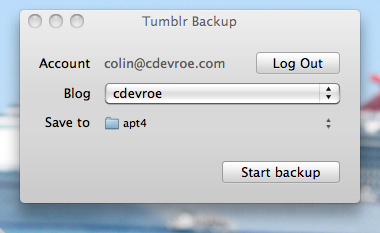
This is just wonderful. Marco Arment has recently released a back up application for Tumblr that is currently only available for Mac OS X. This back up application takes a fairly unique approach among blogging platforms in that it backs up your Tumblog using raw files to your hard disk. It saves HTML files directly to your computer rather than, say, backing up the working files and database used to power a Tumblog and it does so with just one-click.
For contrast here is the way that I currently back up my WordPress powered blog. First, I export the database from mySQL. This can be done a variety of ways (as a CSV file, SQL file, etc.) but the result is the same – I back up the data that mySQL stores to be imported should a failure occur. Already I’ve left 99% of the world’s population wondering what the heck I’m talking about. Second, I copy all of the PHP files that run WordPress, my current theme, and any plugins that I have installed. There are a lot of files that run a WordPress powered site. Technically speaking I don’t need to copy the core WordPress files because those can be downloaded online at any time but I do it so that the back up of my site is a much more complete copy. Third, I copy any and all images and/or downloadable files to my local hard disk to be sure I can restore those should the need arise. It isn’t necessarily difficult to do all of this but if someone wasn’t as geeky as I am (Hi Mom) then I have no idea how they’d pull it off.
This isn’t the fault of WordPress. Comparing WordPress to Tumblr isn’t fair. Comparing WordPress.com to Tumblr, though, is a much more fair comparison. The purpose of WordPress.com, like Tumblr, is to bring blogging to the masses. WordPress.com is a service for people that would have no idea how to do what I described above let alone install and set up WordPress on their own. Presumably the backing up of any WordPress.com-powered blog being done in the background all the time. If a catastrophic failure happened to someone’s WordPress.com-powered blog they could just contact support and get it back up and running. Even the chance of someone’s blog having a failure is less because of it being powered by WordPress.com.
However, this doesn’t mean that they have an easy exit strategy for all of their content. Saving everything you need to restore a blog from WordPress.com is, as far as I know, not possible to do easily. The only options available currently on WordPress.com’s "Export" admin page is to export your posts, pages, and preferences as one big XML file that is only readable by another copy of WordPress.
This back up application for Tumblr is altogether different. When the process is complete you’re left with the content of your Tumblog in a very readable, searchable, and even machine readable set of files. If Marco added an "open the back up in your browser when finished" button I think any caveman (sorry guys) would be able to use and understand this application. Using very simple HTML each of your posts are saved separately, as well as together in monthly archives, which can even be searched using Mac OS X’s very powerful Spotlight search. After backing up my Tumblr account as a test of this application I realized how awesome it is to be able to use Spotlight to find something you’ve written on your blog. Inside of the individual HTML files for each post is also an XML schema, using the same schema as Tumblr’s own API, that can be used to pull out the specific metadata for that post. Brilliant.
I’m not sure why Marco decided against using Microformats, perhaps even in addition to the XML included, to make the HTML files machine readable but that doesn’t matter too much. Everything you need to restore your Tumblog is there. Which brings us to the one big caveat of this back up application. Restoring.
Unless I’m missing something I do not believe there is a way to restore your Tumblog using this application but I also believe that if anyone is going to make that much, much more simple than anyone else it will be the Tumblr team. The true sign of an excellent back up workflow is, as Joel Spolsky recently said, in the process of restoring from that back up.
"The minimum bar for a reliable service is not that you have done a backup, but that you have done a restore."
I think this application is much better than any other backup service or application I’ve seen from competing services. It is dead simple to use and gives you something you can actually use, read, and search on your local computer. Once they get the restore process down they will be ninety-nine miles ahead of everyone else.